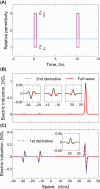Spin-controlled photonics via temporal anisotropy
- PMID: 39635495
- PMCID: PMC11501300
- DOI: 10.1515/nanoph-2022-0809
Spin-controlled photonics via temporal anisotropy
Abstract
Temporal metamaterials, based on time-varying constitutive properties, offer new exciting possibilities for advanced field manipulations. In this study, we explore the capabilities of anisotropic temporal slabs, which rely on abrupt changes in time from isotropic to anisotropic response (and vice versa). Our findings show that these platforms can effectively manipulate the wave-spin dimension, allowing for a range of intriguing spin-controlled photonic operations. We demonstrate these capabilities through examples of spin-dependent analog computing and spin-orbit interaction effects for vortex generation. These results provide new insights into the field of temporal metamaterials, and suggest potential applications in communications, optical processing and quantum technologies.
Keywords: analog computing; anisotropy; metamaterials; spin-orbit interaction; time-varying.
© 2023 the author(s), published by De Gruyter, Berlin/Boston.
Figures








References
-
- Engheta N. Metamaterials with high degrees of freedom: space, time, and more. Nanophotonics. 2021;10(1):639–642. doi: 10.1515/nanoph-2020-0414. - DOI
-
- Caloz C., Deck-Léger Z. Spacetime metamaterials—part I: general concepts. IEEE Trans. Antenn. Propag. 2020;68(3):1569–1582. doi: 10.1109/tap.2019.2944225. - DOI
-
- Caloz C., Deck-Léger Z. Spacetime metamaterials—part II: theory and applications. IEEE Trans. Antenn. Propag. 2020;68(3):1583–1598. doi: 10.1109/tap.2019.2944216. - DOI
-
- Morgenthaler F. R. Velocity modulation of electromagnetic waves. IRE Trans. Microw. Theor. Tech. 1958;6(2):167–172. doi: 10.1109/tmtt.1958.1124533. - DOI
-
- Oliner A. A., Hessel A. Wave propagation in a medium with a progressive sinusoidal disturbance. IRE Trans. Microw. Theor. Tech. 1961;9(4):337–343. doi: 10.1109/tmtt.1961.1125340. - DOI
LinkOut - more resources
Full Text Sources
